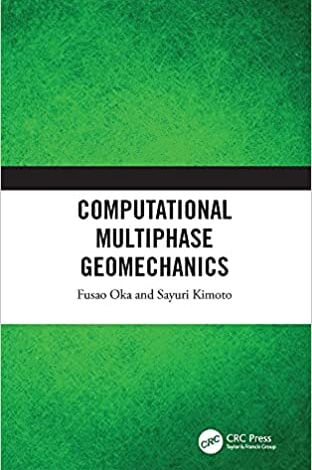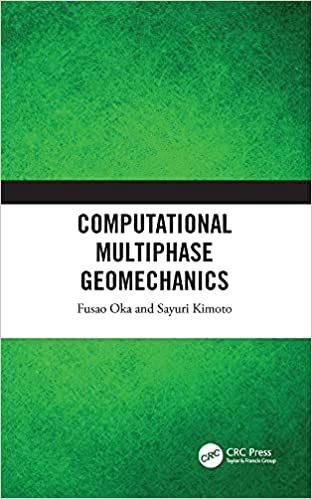دانلود کتاب Computational Multiphase Geomechanics

خرید ایبوک Computational Multiphase Geomechanics
برای دانلود ایبوک Computational Multiphase Geomechanics و خرید کتاب ژئومکانیک چند فازی محاسباتی بر روی کلید خرید در انتهای صفحه کلیک کنید.پس از اتصال به درگاه پرداخت هزینه و تکمیل مراحل خرید ، لینک دانلود کتاب ایمیل می شود.این ایبوک در فرمت PDF اورجینال ارسال می شود.نسخه الکترونیکی کتاب قابلیت کپی برداری copy و Paste دارد.
در صورتی که نیاز به دانلود هر کتابی از آمازون یا گوگل بوک دارید، فقط کافیست ادرس اینترنتی کتاب را از سایت www.amazon.com و یا books.google.com برای ما ارسال کنید (راههای ارتباطی در صفحه تماس با گیگاپیپر ). پس از بررسی، هزینه ان اعلام می شود. پس از واریز نسخه الکترونیکی ارسال می شود.
ایبوک Computational Multiphase Geomechanics

Computational Multiphase Geomechanics 1st Edition
by Fusao Oka (Author), Sayuri Kimoto (Author)
ISBN-13: 978-1032059556
ISBN-10: 1032059559
Download Please Contact Us :
Price : 20$
ادرس اینترنتی کتاب Computational Multiphase Geomechanics
https://www.taylorfrancis.com/books/mono/10.1201/9781003200031/computational-multiphase-geomechanics-fusao-oka-sayuri-kimoto
https://www.routledge.com/Computational-Multiphase-Geomechanics/Oka-Kimoto/p/book/9781032059556
https://www.vitalsource.com/products/computational-multiphase-geomechanics-fusao-oka-sayuri-kimoto-v9781000475043?duration=180
https://www.worldcat.org/title/computational-multiphase-geomechanics/oclc/1260689941
دانلود رایگان کتاب Computational Multiphase Geomechanics
برای اطمینان از کیفیت ایبوک ، چند صفحه ابتدایی ان به صورت رایگان قرار داده شده است.
دانلود کتاب Computational Multiphase Geomechanics
Numerical methods are very powerful tools for use in geotechnical engineering, particularly in computational geotechnics. Interest is strong in the new field of multi-phase nature of geomaterials, and the area of computational geotechnics is expanding.
Alongside their companion volume Computational Modeling of Multiphase Geomaterials (CRC Press, 2012), Fusao Oka and Sayuri Kimoto cover recent progress in several key areas, such as air-water-soil mixture, cyclic constitutive models, anisotropic models, noncoaxial models, gradient models, compaction bands (a form of volumetric strain localization and strain localization under dynamic conditions), and the instability of unsaturated soils.
The text also includes applications of computational modeling to large-scale excavation of ground, liquefaction analysis of levees during earthquakes, methane hydrate development, and the characteristics of contamination using bentonite. The erosion of embankments due to seepage flow is also presented.
دانلود ایبوک ژئومکانیک چند فازی محاسباتی
روشهای عددی ابزارهای بسیار قدرتمندی برای استفاده در مهندسی ژئوتکنیک ، به ویژه در ژئوتکنیک محاسباتی هستند. در زمینه جدید ماهیت چند فازی ژئومواد علاقه زیادی وجود دارد و حوزه ژئوتکنیک محاسباتی در حال گسترش است.
در کنار حجم همراه خود مدل سازی محاسباتی از چندفازی Geomaterials (CRC پرس، 2012)، Fusao و Oka سایوری Kimoto پیشرفت های اخیر در مناطق مختلف کلیدی، مانند مخلوط هوا و آب خاک، مدل ساختاری حلقوی، مدل ناهمسانگرد، مدل های noncoaxial، مدل های شیب پوشش ، نوارهای تراکم (شکلی از محلی سازی کرنش حجمی و محلی سازی کرنش در شرایط پویا) ، و بی ثباتی خاکهای اشباع نشده.
این متن همچنین شامل کاربردهای مدل سازی محاسباتی برای حفاری در مقیاس بزرگ زمین ، تجزیه و تحلیل روانگرایی سطوح در هنگام زلزله ، توسعه هیدرات متان و ویژگی های آلودگی با استفاده از بنتونیت است. فرسایش خاکریزها در اثر جریان نشت نیز ارائه شده است.
فهرست مطالب Computational Multiphase Geomechanics
Cover
Half-Title
Title
Copyright
Contents
Preface
Acknowledgment
Authors
1 Fundamental equations of multiphase geomaterials
1.1 Composition parameters and fundamental phase relations of porous material
1.1.1 Basic quantities
1.1.2 Volumes of air–water–solid three phases and volumetric strains
1.2 Formulation of the constitutive equations for three-phase porous materials
1.2.1 Introduction
1.2.2 General setting for the theory of three-phase porous media
1.2.3 Thermodynamic formulation for multiphase porous materials
1.2.4 Constitutive equations for three-phase porous material
1.2.5 Elastic constitutive model for three-phase porous materials with interaction between fluids and solid
1.2.6 Volumetric linear elastic model for three-phase materials
1.2.7 Skeleton stress
1.2.8 Suction–saturation relation
1.2.9 Usage of skeleton and effective stresses
1.3 Two-phase theory of porous media and the effective stress
1.3.1 Introduction
1.3.2 Theory of solid–fluid two-phase porous media
1.3.2.1 Material parameters of Biot’s solid–fluid two-phase theory
1.3.2.2 Derivation of the effective stress
1.3.2.3 Undrained conditions
1.3.2.4 Unjacketed conditions
1.3.2.5 Drained conditions
1.3.3 Analysis of the isotropic compression tests on dry sand
1.3.3.1 Isotropic compression tests on dry sandy soil
1.3.3.2 Evaluation of pore air pressure
1.3.3.3 Evaluation of the bulk compressibility
1.3.3.4 Discussion of experimental results
References
2 Constitutive models of geomaterials
2.1 Cyclic elasto-plastic constitutive model
2.1.1 Introduction
2.1.2 Cyclic elasto-plastic constitutive model
2.1.2.1 Total strain rate tensor
2.1.2.2 Overconsolidation boundary surface
2.1.2.3 Yield function
2.1.2.4 Failure conditions
2.1.2.5 Plastic potential function
2.1.2.6 Plastic flow rule
2.1.3 Simulation results
2.1.3.1 Determination of parameters
2.1.3.2 Comparison with experimental results
2.1.3.3 Effect of non-associativity parameter
2.1.3.4 Effect of degradation parameters
2.2 Cyclic elasto-viscoplastic constitutive model
2.2.1 Introduction
2.2.2 Cyclic elasto-viscoplastic constitutive equation
2.2.2.1 Elastic strain rate tensor
2.2.2.2 Overconsolidation boundary surface
2.2.2.3 Static yield function
2.2.2.4 Viscoplastic potential function
2.2.2.5 Viscoplastic flow rule
2.2.2.6 Kinematic hardening rules
2.2.2.7 Total strain rate tensor
2.2.2.8 Determination of material parameters
2.2.2.9 Simulation results of cyclic triaxial compression tests
2.3 Transversely anisotropic and pseudo-anisotropic viscoplastic models
2.3.1 Transformed stress tensor
2.3.2 Transversely isotropic model of clay
2.3.3 Elastic anisotropic model
2.3.4 Current stress-induced pseudo-anisotropic failure conditions
2.3.5 Elasto-viscoplastic constitutive equation for clay based on the transformed stress tensor
2.3.6 Non-coaxiality and deviatoric flow rule
2.3.7 Constitutive equations for large strain
2.4 Constitutive models for unsaturated soils
2.4.1 Overconsolidation boundary surface
2.4.2 Yield function
2.4.3 Kinematic hardening rule
2.4.4 Compression parameter
2.4.5 Hydraulic constitutive equations of unsaturated soil
2.4.6 Simulation of cyclic drained tests for unsaturated sandy soil
2.4.7 Simulation of fully undrained triaxial tests for unsaturated sandy soil
2.4.7.1 Test results
2.4.7.2 Simulation results
2.5 Non-coaxial constitutive models
2.5.1 Introduction
2.5.2 Double shearing model
2.5.2.1 Derivation of velocity equations
2.5.2.2 Double shearing constitutive theory
2.5.3 Anand’s model
2.5.4 Total strain theory and the non-coaxial term
2.6 Gradient-dependent elastic model for granular materials and strain localization solution
2.6.1 First gradient-dependent elastic model
2.6.2 Second gradient-dependent elastic model
2.6.3 Solutions of gradient-dependent elastic models
2.6.3.1 Solution of the second-gradient elastic model
2.6.3.2 Solution of the first gradient-dependent elastic model
2.7 Strain-softening constitutive model considering the memory and internal variables
2.7.1 Introduction
2.7.2 Interpretation of the strain-softening process
2.7.3 Inherent strain measure, stress history tensor, and kernel function
2.7.4 Flow rule and yield function
2.7.5 Elastic boundary surface
2.7.6 Plastic potential function and overconsolidation boundary surface
2.7.7 Strain-hardening and strain-softening parameter
2.7.8 Elasto-plastic constitutive model with strain softening
2.7.9 Uniqueness of the solution for the initial value problem
2.7.10 Simulation of triaxial compression test results of sedimentary soft rock
2.8 Strain-softening constitutive model for frozen soil
2.8.1 Introduction
2.8.2 Elasto-viscoplastic softening model for frozen sand
2.8.3 Instability analysis of the model
2.8.4 Simulation of the triaxial experimental results
Appendix A2.1 Convexity of failure surface
Appendix A2.2 Hirota’s bi-linear differential operator (Hirota 1976)
References
3 Governing equations and finite element formulation for large deformation of three-phase materials
3.1 Governing equations for three-phase geomaterials
3.1.1 Partial stress tensors for the mixture
3.1.2 Conservation of mass
3.1.3 Conservation of linear momentum
3.1.4 Equation of motion for the whole mixture
3.1.5 Continuity equations for fluid phases
3.1.6 Suction–saturation characteristic curve of unsaturated soil
3.2 Finite element discretization of governing equations
3.2.1 Discretization of equation of motion for the whole mixture
3.2.2 Discretization of continuity equations
3.2.3 Discretization of governing equations in time domain
3.2.4 Final form of discretized governing equations
References
4 Strain localization in geomaterials
4.1 Strain localization modes in porous material: Shear and compaction bands
4.1.1 Strain localization analysis using Mohr’s stress circle
4.1.2 Summary
4.2 Elasto-viscoplastic numerical analysis of compaction bands of diatomaceous mudstone
4.2.1 Introduction
4.2.2 Behavior of diatomaceous mudstone
4.2.2.1 Triaxial testing procedure
4.2.2.2 Triaxial test results
4.2.2.3 Image analysis results
4.2.3 Elasto-viscoplastic constitutive equations
4.2.4 Elasto-viscoplastic finite element analysis
4.2.4.1 Finite element analysis method
4.2.4.2 Numerical results and discussions
4.2.5 Summary
4.3 Numerical analysis of dynamic strain localization of saturated and unsaturated soils
4.3.1 Introduction
4.3.2 Dynamic strain localization analysis of soil
4.3.2.1 Discretization of governing equations and constitutive equations
4.3.2.2 Finite element mesh, loading, and boundary conditions
4.3.2.3 Material and numerical parameters
4.3.3 Numerical results of strain localization
4.3.4 Summary
Appendix A4.1 Three-dimensional Mohr stress circle (Mohr 1882; Malvern 1969)
References
5 Instability analysis of water infiltration into an unsaturated elasto-viscoplastic material
5.1 Introduction
5.2 One-dimensional instability analysis of water infiltration into unsaturated viscoplastic porous media
5.2.1 Governing equations
5.2.2 Perturbed governing equations
5.2.3 Instability conditions
5.3 Numerical simulation of one-dimensional infiltration problem
5.3.1 Simulation results of the one-dimensional infiltration problem
5.3.2 Discussions on stability
5.4 Simulation of the experimental results
References
6 Numerical simulation of rainfall infiltration on unsaturated soil slope
6.1 Introduction
6.2 Case study of slope stability
6.2.1 Measurement data and numerical analysis
6.2.2 Effect of permeability
References
7 Dynamic analysis of a levee during earthquakes
7.1 Introduction
7.2 Patterns of failure in river embankments subjected to seismic loading
7.3 Dynamic analysis of embankment
7.3.1 Governing equations
7.3.2 Constitutive equations
7.3.3 Conservation equations and discretization
7.3.4 Simulation model of river embankment and input earthquake
7.3.5 Simulation results
7.4 Summary
References
8 Numerical analysis of excavation in soft ground
8.1 Introduction
8.2 Geotechnical profile at the excavation site
8.3 Outline of the excavation project
8.4 Soil improvement technique
8.5 Excavation process
8.6 Numerical simulation
8.6.1 Elasto-viscoplastic constitutive equation
8.6.2 Determination of material parameters used in the analysis
8.6.3 Numerical modeling of excavation
8.7 Numerical results and comparisons with measurements
8.7.1 Comparison of measured and simulated results
8.7.1.1 Displacement of earth retaining wall
8.7.1.2 Settlements and pore water pressure in layers
8.8 Summary
References
9 Elasto-viscoplastic constitutive modeling of the swelling process of unsaturated clay
9.1 Introduction
9.2 Elasto-viscoplastic constitutive model for unsaturated swelling soil
9.2.1 Model assumptions
9.2.2 Swelling equation for interparticles
9.2.3 Viscoplastic model including swelling effect
9.3 Simulation of swelling pressure tests
9.3.1 Analysis method and the model
9.3.2 Swelling pressure with wetting process
9.3.3 Swelling pressure with different permeabilities
9.3.4 Swelling pressure with different levels of onset saturation for swelling
9.3.5 Effect of γ on the swelling pressure
9.3.6 Effect of A on the swelling pressure
9.3.7 Swelling pressure considering the initial dry density and the water content
9.4 Application to Kunigel GX bentonite
9.5 Summary
References
10 Numerical analysis of hydrate-bearing subsoil during dissociation
10.1 Introduction
10.2 Multiphase mixture theory for soil containing hydrate
10.2.1 General setting
10.2.2 Definition of stress
10.2.3 Conservation of mass
10.2.4 Conservation of linear momentum
10.2.5 Weak form of the total balance of the linear momentum
10.2.6 Conservation of energy
10.2.7 Soil-water characteristic curve
10.2.8 Dissociation of hydrates
10.3 Elasto-viscoplastic model for unsaturated soil containing hydrate
10.4 Numerical model and simulation
10.4.1 Simulation model
10.4.2 Simulation results
10.5 Summary
References
11 A numerical model for the internal erosion of geomaterials
11.1 Introduction
11.2 Equations of motion and mass balance equations
11.2.1 General setting for the mixture
11.2.2 Partial stress and effective stress
11.2.3 Conservation of linear momentum
11.2.4 Conservation of mass
11.3 Evolutional equation of the internal erosion
11.4 Permeability coefficient
11.5 Numerical analysis method
11.6 Numerical results
11.7 Summary
References
- Index